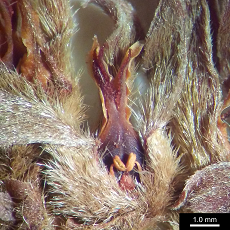
Publicado
Notes on the floral sexuality of some species of the tree genus Triplaris (Polygonaceae)
Notas sobre la sexualidad floral de algunas especies del género arbóreo Triplaris (Polygonaceae)
DOI:
https://doi.org/10.15446/caldasia.v44n2.93314Palabras clave:
Dioecy, Reproductive Biology (en)Diocia, Biología Reproductiva (es)
Descargas
The majority of angiosperms (~94 %) are synoecious, with only a small minority separating the production of the two gamete types onto different biological individuals (dioecy). For many plant species, however, reproductive systems and habits are not well documented. This is particularly true of tropical trees, which, despite their conspicuity, are poorly understood. Plants in the genus Triplaris have been consistently described as strictly dioecious. After morphologic analysis using a dissecting microscope, here I present a number of fully-formed perfect (hermaphroditic) flowers observed on Triplaris herbaria specimens.
La mayoría de las angiospermas (~94 %) son sinóicas, y sólo una pequeña minoría separa la producción de los dos tipos de gametos en distintos individuos biológicos (dioica). Sin embargo, los sistemas y hábitos reproductivos de muchas especies vegetales no están bien documentados. Esto es particularmente cierto en el caso de los árboles tropicales, que, a pesar de su conspicuidad, son poco conocidos. Las plantas del género Triplaris han sido descritas sistemáticamente como estrictamente dioicas. Luego del estudio morfológico utilizando un microscopio de disección, presento la observación de un número de flores perfectas (hermafroditas) completamente formadas observadas en especímenes de herbario pertenecientes al género Triplaris.
Referencias
Barrett SCH. 2013. The evolution of plant reproductive systems: how often are transitions irreversible? Proc. R. Soc. London, Ser. B. 280:20130913. doi: https://doi.org/10.1098/rspb.2013.0913
Bawa KS. 1974. Breeding systems of tree species of a lowland tropical community. Evolution 28(1):85-92. doi: https://doi.org/10.1111/j.1558-5646.1974.tb00729.x
Bawa KS. 1980. Evolution of dioecy in flowering plants. Annu. Rev. Ecol. Syst. 11:15-39. doi: https://doi.org/10.1146/annurev.es.11.110180.000311
Bawa KS, Opler PA. 1975. Dioecism in tropical forest trees. Evolution 29(1):167-179. doi: https://doi.org/10.1111/j.1558-5646.1975.tb00824.x
Bawa KS, Bullock SH, Perry DR, Coville RE, Grayum MH. 1985a. Reproductive biology of tropical lowland rainforest trees. II. Pollination systems. Am. J. Bot. 72(3):346-356. doi: https://doi.org/10.1002/j.1537-2197.1985.tb05358.x
Bawa KS, Perry DR, Beach JH. 1985b. Reproductive biology of tropical lowland rainforest trees. I. Sexual systems and incompatibility mechanisms. Am. J. Bot. 72(3):331-345. doi: https://doi.org/10.1002/j.1537-2197.1985.tb05357.x
Brandbyge J. 1984. Three new species of the genus Triplaris (Polygonaceae). Nord. J. Bot. 4(6):761-764. doi: https://doi.org/10.1111/j.1756-1051.1984.tb02006.x
Brandbyge J. 1986. A revision of the genus Triplaris (Polygonaceae). Nord. J. Bot. 6(5):545-569. doi: https://doi.org/10.1111/j.1756-1051.1986.tb00454.x
Brandbyge J. 1990. Woody Polygonaceae from Brazil: new species and a new interpretation. Nord. J. Bot. 10(2):155-160. doi: https://doi.org/10.1111/j.1756-1051.1990.tb01763.x
Brandbyge J, Øllgaard B. 1984. Inflorescence structure and generic delimitation of Triplaris and Ruprechtia (Polygonaceae). Nord. J. Bot. 4(6):765-769. doi: https://doi.org/10.1111/j.1756-1051.1984.tb02007.x
Bullock SH. 1994. Wind pollination of Neotropical dioecious trees. Biotropica 26(2):172-179. doi: https://doi.org/10.2307/2388806
Burke JM, Sanchez A. 2011. Revised subfamily classification for Polygonaceae, with a tribal classification for Eriogonoideae. Brittonia 63:510-520. doi: https://doi.org/10.1007/s12228-011-9197-x
Firmage DH, Dafni A. 2001. Field tests for pollen viability: a comparative approach. Acta Hortic. 561:87-94. doi: https://doi.org/10.17660/ActaHortic.2001.561.13
Fox JF. 1985. Incidence of dioecy in relation to growth form, pollination and dispersal. Oecologia 67:244-249. doi: https://doi.org/10.1007/BF00384293
Givnish TJ. 1980. Ecological constraints on the evolution of breeding systems in seed plants: dioecy and dispersal in gymnosperms. Evolution 34(5):959-972. doi: https://doi.org/10.2307/2408001
Madriz R, Ramírez N. 1996-1997. Biología reproductiva de Coccoloba uvifera (Polygonaceae) una especie poligamo-dioica. Rev. Biol. Trop. 44/45:105-115.
Meisner CF. 1856. Polygonaceae. In: Candolle A, editor. Prodromus Systematis Naturalis Regni Vegetabilis. Paris. 14:1-186.
Ming R, Bendahmane A, Renner SS. 2011. Sex chromosomes in land plants. Annu. Rev. Plant Biol. 62:485-514. doi: https://doi.org/10.1146/annurev-arplant-042110-103914
Melampy MN, Howe HF. 1977. Sex ratio in the tropical tree Triplaris americana (Polygonaceae). Evolution 31(4):867-872. doi: https://doi.org/10.2307/2407449
Opler PA, Bawa KS. 1978. Sex ratios in tropical forest trees. Evolution 32(4):812-821. doi: https://doi.org/10.2307/2407496
Pacini E, Franchi GG. 2020. Pollen biodiversity – why are pollen grains different despite having the same function? A review. Bot. J. Linn. Soc. 193(2):141-164. doi: https://doi.org/10.1093/botlinnean/boaa014
Renner SS. 2014. The relative and absolute frequencies of angiosperm sexual systems: dioecy, monoecy, gynodioecy, and an updated online database. Am. J. Bot. 101(10):1588-1596. doi: https://doi.org/10.3732/ajb.1400196
Renner SS, Ricklefs RE. 1995. Dioecy and its correlates in the flowering plants. Am. J. Bot. 82(5):596-606. doi: https://doi.org/10.1002/j.1537-2197.1995.tb11504.x
Renner SS, Won H. 2001. Repeated evolution of dioecy from monoecy in Siparunaceae (Laurales). Syst. Biol. 50(5):700-712. doi: https://doi.org/10.1080/106351501753328820
Sanchez A. 2015. Fidelity and promiscuity in an ant-plant mutualism: a case study of Triplaris and Pseudomyrmex. Plos One. doi: https://doi.org/10.1371/journal.pone.0143535
Wei N, Dick CW. 2014. Polymorphic microsatellite markers for a wind-dispersed tropical tree species, Triplaris cumingiana (Polygonaceae). Appl. Plant Sci. 2(9):1400051. doi: https://doi.org/10.3732/apps.1400051
Cómo citar
APA
ACM
ACS
ABNT
Chicago
Harvard
IEEE
MLA
Turabian
Vancouver
Descargar cita
Licencia

Esta obra está bajo una licencia internacional Creative Commons Atribución 4.0.
Aquellos autores/as que tengan publicaciones con esta revista, aceptan los términos siguientes:
- Los autores/as conservarán sus derechos de autor y garantizarán a la revista el derecho de primera publicación de su obra, el cual estará simultáneamente sujeto a la Licencia de reconocimiento de Creative Commons que permite a terceros compartir la obra siempre que se indique su autor y su primera publicación esta revista.
- Los autores/as podrán adoptar otros acuerdos de licencia no exclusiva de distribución de la versión de la obra publicada (p. ej.: depositarla en un archivo telemático institucional o publicarla en un volumen monográfico) siempre que se indique la publicación inicial en esta revista.
- Se permite y recomienda a los autores/as difundir su obra a través de Internet (p. ej.: en archivos telemáticos institucionales o en su página web) antes y durante el proceso de envío, lo cual puede producir intercambios interesantes y aumentar las citas de la obra publicada. (Véase El efecto del acceso abierto).























